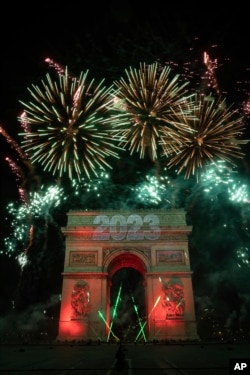With fireworks in London, Paris and Berlin, hopes for an end to the war in Ukraine and a return to post-COVID normality, Europe and Asia bid farewell to 2022.
It was a year marked by the conflict in Ukraine, economic stresses and the effects of global warming. But it was also a year that saw a dramatic World Cup, rapid technological change, and efforts to meet climate challenges.
For Ukraine, there seemed to be no end in sight to the fighting that began when Russia invaded in February. On Saturday, Russia fired a barrage of cruise missiles that Ukraine’s human rights ombudsman described as “terror on New Year’s Eve.”
Evening curfews remained in place nationwide, making the celebration of the beginning of 2023 impossible in many public spaces. Several regional governors posted messages on social media warning residents not to break restrictions.
In Kyiv, though, people gathered near the city’s central Christmas tree as midnight approached.
“We are not giving up. They couldn’t ruin our celebrations,” said 36-year-old Yaryna, who was celebrating with her husband, tinsel and fairy lights wrapped around her.
In a video message to mark the new year, Ukrainian President Volodymyr Zelenskyy said: “I want to wish all of us one thing: victory.”
Soon after midnight, air raid sirens wailed across the country once again.
Russian President Vladimir Putin devoted his New Year’s address to rallying the Russian people behind his troops.
Festivities in Moscow were muted, without the usual fireworks on Red Square.
“One should not pretend that nothing is happening — our people are dying (in Ukraine),” said 68-year-old Yelena Popova. “A holiday is being celebrated, but there must be limits.” Many Muscovites said they hoped for peace in 2023.
The London Eye turned blue and yellow in solidarity with Ukraine as fireworks saw in midnight in the British capital.
The celebration, which London’s mayor had branded the biggest in Europe, also referenced Queen Elizabeth II, who died in September, the red and white of England’s soccer team, and the rainbow colors of the LGBTQ Pride event, which had its 50-year anniversary in 2022.
Elsewhere in the region, fireworks exploded over the Parthenon in Athens, the Brandenburg Gate in Berlin, and the Arc de Triomphe in Paris, where crowds gathered on the Champs-Elysees to watch the French capital’s first New Year’s fireworks since 2019.
Like many places, the Czech capital, Prague, was feeling the pinch economically and so did not hold a fireworks display.
“Holding celebrations did not seem appropriate,” said city hall spokesperson Vit Hofman.
Heavy rain and high winds meant firework shows in the Netherlands’ main cities were canceled.
But several European cities were enjoying record warmth for the time of year. In Prague, it was the warmest New Year’s Eve in its 247 years of records, with temperatures reaching 17.7 Celsius.
It was also the warmest New Year’s Eve recorded in France, official weather forecaster Meteo France said.
Earlier, Australia kicked off the celebrations with its first restriction-free New Year’s Eve after two years of COVID disruptions.
Sydney welcomed the new year with a typically dazzling fireworks display, which for the first time featured a rainbow waterfall off the Harbour Bridge.
“This New Year’s Eve we are saying Sydney is back as we kick off festivities around the world and bring in the new year with a bang,” said Clover Moore, lord mayor of the city.
Pandemic-era curbs on celebrations were lifted this year after Australia, like many countries around the world, reopened its borders and removed social distancing restrictions.
In China, rigorous COVID restrictions were lifted only in December as the government reversed its zero-COVID policy, a switch that has led to soaring infections and meant some people were in no mood to celebrate.
“This virus should just go and die; cannot believe this year I cannot even find a healthy friend that can go out with me,” wrote one social media user based in eastern Shandong province.
But in the city of Wuhan, where the pandemic began three years ago, thousands of people gathered to enjoy themselves despite a heavy security presence, releasing balloons into the sky when the clocks struck midnight.
Barricades were erected and hundreds of police officers stood guard. Loudspeakers blasted out a message on a loop advising people not to gather. But the large crowds of revelers took no notice.
In Shanghai, many thronged the historic riverside walkway, the Bund.
“We’ve all traveled in from Chengdu to celebrate in Shanghai,” said Da Dai, a 28-year-old digital media executive who was visiting with two friends. “We’ve already had COVID, so now feel it’s safe to enjoy ourselves.”
In Hong Kong, days after limits were lifted on group gatherings, tens of thousands of people met near Victoria Harbour for a countdown to midnight — the city’s biggest New Year’s Eve celebration in several years. The event was canceled in 2019 because of often violent social unrest, then scaled down in 2020 and 2021 because of the pandemic.

